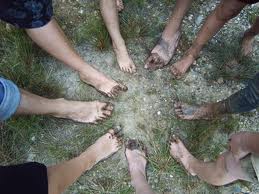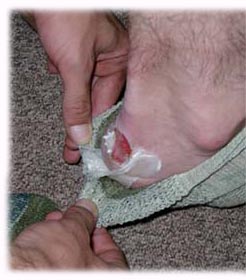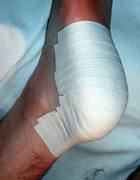|
|
| |
|
|
 Over the centuries our feet have been developed to cope with uneven and rough terrain. Because, the flat surface of our cities made our feet lazy,
they need extra time to get used to the extra load and the rougher terrain. Here are some tips for training your feet before you go hiking.
* Train your feet by simply walk far.
* Walk barefoot, whenever possible.
* Remove excess callus (skin file)
* Treat fungus (athlete's foot), consult a physician.
* Cut your toenails. Clear ingrowth organized and sharp edges before you go hiking.
Over the centuries our feet have been developed to cope with uneven and rough terrain. Because, the flat surface of our cities made our feet lazy,
they need extra time to get used to the extra load and the rougher terrain. Here are some tips for training your feet before you go hiking.
* Train your feet by simply walk far.
* Walk barefoot, whenever possible.
* Remove excess callus (skin file)
* Treat fungus (athlete's foot), consult a physician.
* Cut your toenails. Clear ingrowth organized and sharp edges before you go hiking. |
| |
|
Blisters
|
 Blisters are the most frequent disorders while hiking, with blisters even the most beautiful can turn into a trip in a hell.
Blisters can be prevented by proper training, proper shoes and socks, and an early recognition of the problem.
The Origin of Blisters?
Blisters are the most frequent disorders while hiking, with blisters even the most beautiful can turn into a trip in a hell.
Blisters can be prevented by proper training, proper shoes and socks, and an early recognition of the problem.
The Origin of Blisters? |
| Heat |
The main cause of blisters.
The heat, wich causes blisters, is usually caused by the friction between your skin and your shoe. Sand and dust may be rubbing inside your shoe
wich enlarges the effect. |
| Moist |
Moisture Damp or wet feet, sweat or water, are more prone to blisters, because moisture will soften your skin. |
| Salt |
Sweat is not only wet but also contains salts. When the salt crystallizes by drying, this like sand, becomes an abrasive.
For this reason always wear clean socks. |
|
|
Preventing blisters?
To prevent blisters, you need to obstruct the factors that cause them. |
| First you need good shoes, shoes that fit and do not have annoying pressurepoints.
Take waterproof breathable shoes, wich ventilate and drain excess fluids. Look for oversized and sealed tongues what keeps dirt out. |
| Give your feet enough rest, if you think your feet are warm and moist, it is wise to adjust your rhythm and take longer breaks,
on wich you take off shoes and socks. Change your socks and shoes, and let the previous ones dry. Alternating between two pairs of socks is often
effective. (wash the worn socks) |
| If you decide to cool your feet in a creek, dry them thoroughly before putting your socks and shoes on. Water makes your skin softer and
more vulnerable. Let your feet breathe after drying. |
Use moisture-absorbing soles to keep out of your shoes. |
|
Blisters need time to occur, often when you feel a blister coming up. If take action right away, you can prevent blisters.
Painful or irritating places need to be treated as follows:
| Put off your shoes and socks and wash your feet. |
| Let your feet cool, dry and breathe. |
| Put on clean, dry socks and shoes. Preferably change shoes or wear hiking sandals. |
You might want to wear special blister plaster, or rather put second-skin onto the painful area. |
|
| |
|
Treat blisters
|
If a blister has formed, and you still want to walk, it can give relief to drain the blister.
Note that when a blister is closed, it remains sterile and will not infect.
Drain closed blisters.
Sterilize a needle and prick a hole in the blister. Press all liquid out of the blister.
Leave the skin and paste the entire blister with second-skin.
If you do not have second-skin on stock, tape the blister pan-wise (see, open blister).
Ruptured blisters.
 With a ruptured blister, you remove present skin debris. Wash the wound and then sterilize it.
Cover the wound with sterile gauze and stick it off with adhesive plaster. The taping is done pan-wise.
You start at the bottom and work upward by covering half of the previous tape. Unlike the picture only paste the blister.
With a ruptured blister, you remove present skin debris. Wash the wound and then sterilize it.
Cover the wound with sterile gauze and stick it off with adhesive plaster. The taping is done pan-wise.
You start at the bottom and work upward by covering half of the previous tape. Unlike the picture only paste the blister. |
|
|
|
|
| |